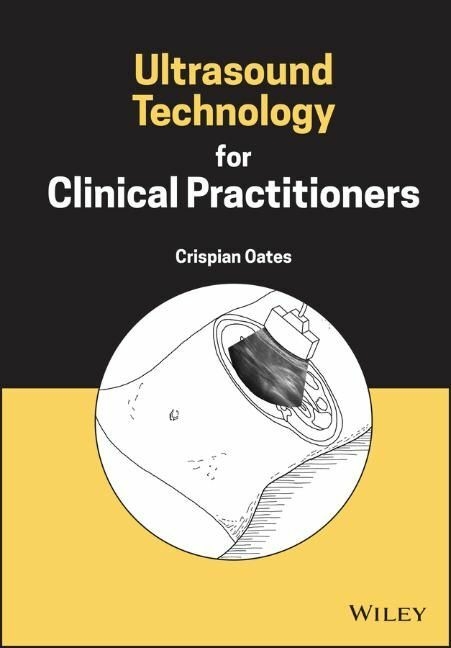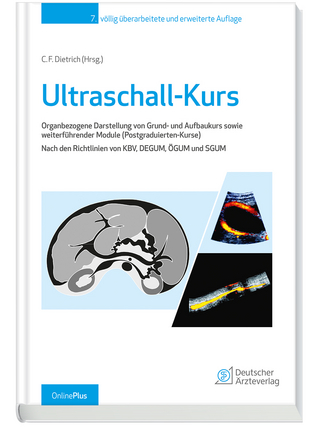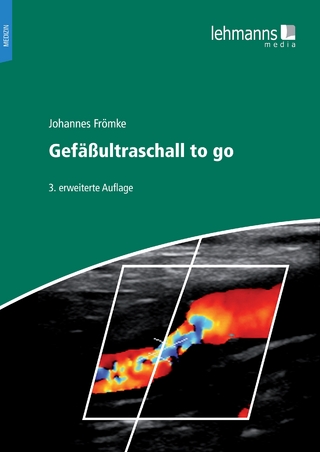
Ultrasound Technology for Clinical Practitioners
Wiley-Blackwell (Verlag)
978-1-119-89155-0 (ISBN)
In »Ultrasound Technology for Clinical Practitioners«, distinguished medical physicist and vascular ultrasound scientist Crispian Oates delivers an accessible and practical resource written for the everyday clinical user of ultrasound. The book offers complete descriptions of the latest techniques in ultrasound, including ultrafast ultrasound and elastography, providing an up-to-date and relevant resource for educators, students, and practitioners alike.
»Ultrasound Technology for Clinical Practitioners« uses a first-person perspective that walks readers through a relevant and memorable story containing necessary information, simplifying retention and learning. It makes extensive use of bulleted lists, diagrams, and images, and relies on mathematics and equations only where necessary to illustrate the relationship between other factors. Physics examples come from commonly known contexts that readers can relate to their everyday lives, and additional description boxes offer optional, helpful info in some topic areas.
Readers will also find:
- A thorough introduction to the foundational physics of ultrasound, as well as the propagation of the ultrasound pulse through tissue
- Comprehensive discussions of beam shapes, transducers, imaging techniques, and pulse echo instrumentation
- In-depth examination of image quality and artefacts and the principles of Doppler and colour Doppler ultrasound
- Fulsome treatments of measurement taking and safety and quality assurance in ultrasound
Perfect for sonographers, echocardiographers, and vascular scientists, »Ultrasound Technology for Clinical Practitioners« will also earn a place in the libraries of radiologists, cardiologists, emergency medicine specialists, and all other clinical users of ultrasound.
Crispian Oates is a Medical Physicist and Clinical Scientist in ultrasound. He helped devise the physics and technology curriculum for the Vascular Ultrasound track of the NHS Scientist Training Programme and sits on the Consortium for the Accreditation of Sonographic Education CASE. He is also a vascular ultrasound scientist at the Vascular Laboratories in Newcastle, Sunderland, and Durham in the United Kingdom.
Acknowledgments xvii
List of Abbreviations xix
Introduction 1
Chapter 1 The Basic Physics of Ultrasound 5
Sound Waves 5
Describing Waves 9
Energy in a Sound Wave 11
Ultrasound Pulses 12
Energy Spectrum of a Pulse 13
Bandwidth 14
Speed of Sound (C) 16
Characteristic Acoustic Impedance, Z0 20
Energy in a Sound Wave 22
Decibels 23
Chapter 2 The Interaction of Ultrasound with Tissue 25
Reflection and Transmission at a Plane Interface 25
Poor Visualisation 29
Scattering 30
Attenuation 34
The Journey of the Ultrasound Pulse 37
User Control 37
References 38
Chapter 3 Beam Shapes 39
Simple Beam Shape Model 40
Huygen’s Wavelet Model and Diffraction 43
Focusing 44
Beam Forming with Transducer Arrays 47
Beam Steering 50
Electronic Focusing 52
Resolution 54
Clutter 58
Reference 58
Chapter 4 The Ultrasound Probe 59
The Transducer 59
Backing Layer 62
Matching Layer 63
Front Face Lens 65
Wide Band Transducers 65
Construction of an Array 66
CMUT Technology 66
1-D, 1.5-D, and 2-D Arrays 68
References 72
Chapter 5 Image Formation 73
Image Modes 74
Linear Image Formation 76
3D Imaging 80
Cine Loop 82
Endoprobes 82
Choosing A Probe 84
Focusing 84
Increasing Frame Rate 86
User Control 86
Ultrasound Harmonics 89
Coded Excitation 92
References 94
Chapter 6 The B-Mode Scanner 95
Transmission Side of a Scanner 95
User Controls 96
Receive Side of a Scanner (Rx) 97
Advantages of Digitising 101
Dynamic Range and Transfer Function (Greyscale Mapping) 102
Contrast Resolution 106
User Controls 106
Image Memory 106
Frame Freeze 106
Read and Write Zoom 107
Image Processing 108
User Control 108
Chapter 7 Image Quality and Artefacts 111
Acoustic Window 111
Frame Rate: Frames Per Second (fps) 112
Interlacing Scan Lines 113
Interpolation – Writing in ‘Extra Lines’ 114
Speckle 115
Frame Averaging or Persistence 116
User Control 117
Spatial Compound Imaging 117
Adaptive Filtering 118
Artefacts 122
Speed of Sound Artefacts 122
Attenuation Artefacts 127
Reflection Artefacts 130
Anisotropy 134
Beam Shape Artefacts 135
Temporal Artefacts 137
Final Example 139
References 140
Chapter 8 Principles of Doppler Ultrasound 141
The Doppler Effect 141
The Doppler Equation 143
Duplex Ultrasound 144
CW Doppler 145
CW Doppler Summary 152
Pulsed Wave Doppler (PW Doppler) and Range Gating 152
Intrinsic Spectral Broadening (ISB) 160
Question: What Doppler Angle Should We Use? 162
User Controls 163
Peak Velocity Envelope 165
Average Velocity 167
Doppler Artefacts 170
References 173
Chapter 9 Principles of Colour Doppler Ultrasound 175
Autocorrelation 177
Colour Scale 180
Frame Rate 181
User Controls 181
CDU and the Doppler Angle 183
Colour Aliasing 183
User Controls 185
Discrimination of Stationary Targets 187
User Controls 188
Power Doppler (PD) 188
CDU Artefacts 190
Colour Sensitivity 192
Presets 194
Colour M-Mode 194
Tissue Doppler Imaging (TDI) 194
Myocardial Strain Imaging 197
Speckle Tracking Echocardiography STE 199
References 202
Chapter 10 Making Measurements 203
Accuracy 204
Precision 204
How Accurate or Precise Do We Need To Be? 205
Reproducibility 205
Systematic and Random Errors 206
Ultrasound Measurements in Practice 206
Physical Constraints 207
Sonographer-Based Constraints 209
Principles for Making Reliable Measurements 209
Measurement of Circumference, Area, and Volume 213
Doppler Waveform Measurements 216
Waveform Indices 219
Colour Doppler Ultrasound 221
Measurement of Volume Flow Q 221
References 224
Chapter 11 Safety and Quality Assurance 225
Energy, Power, and Intensity 226
Measuring Intensity 227
Intensity 227
Factors Affecting Damage Potential 230
Thermal Effects 231
Thermal Index (TI) 232
Transducer Self-Heating 234
Nonthermal Effects 235
Radiation Force 235
Streaming 235
Cavitation 236
Mechanical Index (MI) 239
Alara 239
Contrast Agents 240
Quality Assurance and Routine Checks 241
Suggested Routine User Checks 241
The Use of Test Objects 244
Personal Risk Management 245
New Techniques in Ultrasound 246
References 247
Chapter 12 Advanced Topics 249
Contrast Agents (CA) 249
Behaviour of Bubbles in the Ultrasound Field 251
Contrast Agent Harmonics 252
Flashing 254
Advanced Micro-Bubble Techniques 255
B-Flow Blood Vessel Imaging 256
Doppler Measurement of Pressure Gradients 260
Advanced Image Processing 261
Artificial Intelligence 261
Segmentation 262
Examples (1–3) 262
Computer-Aided Diagnosis (CAD) 263
Diagnosis with Cad 268
Fusion Imaging 269
Needle Visualisation and Guidance 271
References 274
Chapter 13 Ultrafast Ultrasound 277
Synthetic Aperture Imaging (SA) 278
Plane-Wave Beamforming 279
Summary 283
Speed of Sound Correction 283
Ultrafast Doppler 286
Vector Flow Imaging (VFI) 291
References 298
Chapter 14 Elastography 301
Background Theory 302
Elastography 303
Methods of Applying The Distorting Force 303
Strain Elastography (SE) 303
User Controls 307
SE Artefacts 310
Acoustic Radiation Force Impulse Imaging (ARFI Imaging) 314
Strain Ratio 316
Shear Wave Elastography (SWE) 316
Point SWE (PSWE) 320
Supersonic Shear Imaging (SSI) 322
Shear Wave Compounding 323
SWE Artefacts 325
References 326
Appendix 1: Knobology 329
Appendix 2: Handling Equations and Decibels 335
Appendix 3: The Unfocused Transducer Beam Shape 345
Index 349
| Erscheinungsdatum | 17.02.2023 |
|---|---|
| Verlagsort | Hoboken |
| Sprache | englisch |
| Maße | 171 x 249 mm |
| Gewicht | 910 g |
| Einbandart | gebunden |
| Themenwelt | Medizinische Fachgebiete ► Radiologie / Bildgebende Verfahren ► Sonographie / Echokardiographie |
| Naturwissenschaften ► Physik / Astronomie | |
| Technik ► Umwelttechnik / Biotechnologie | |
| ISBN-10 | 1-119-89155-8 / 1119891558 |
| ISBN-13 | 978-1-119-89155-0 / 9781119891550 |
| Zustand | Neuware |
| Haben Sie eine Frage zum Produkt? |
aus dem Bereich


